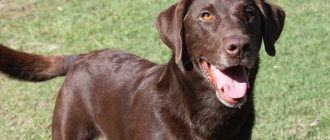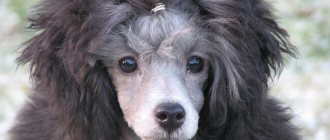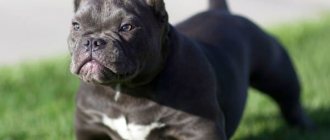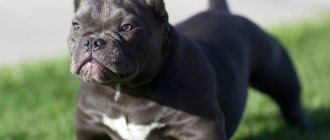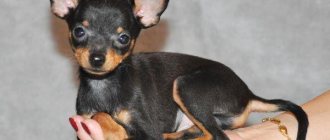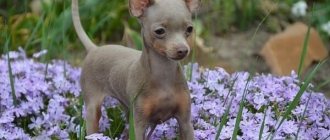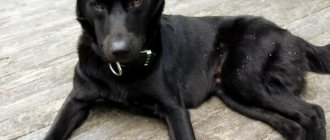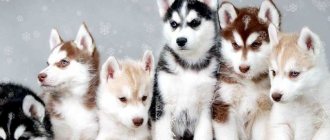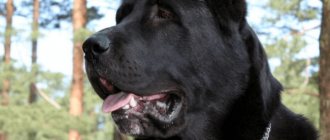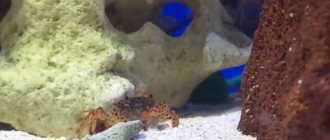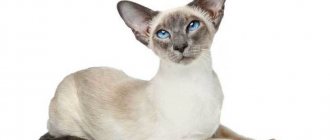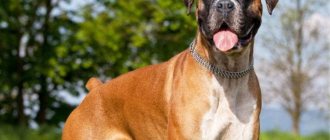From their distant ancestors - Canadian small Newfoundlands and English retrievers, Labradors inherited boundless devotion to their owner and excellent working qualities.
Originally bred for gun hunting, Labradors are now more often used as companion dogs, guide dogs, and rescue dogs.
The first Labradors were brought to the USSR in the 60-70s of the last century, but they were not particularly popular and did not enjoy universal love.
Everything changed in 2000, when Sergei Shoigu, who was then head of the Ministry of Emergency Situations, gave a Labrador puppy named Connie Polgrave to Russian President Vladimir Putin.
After widespread press coverage of this event and subsequent frequent reports about the life of Putin's dog, Labradors became one of the most popular breeds in our country.
Do mini Labradors exist and what do they look like in the photo?
Many people dream of owning a Labrador.
But Connie’s relatives are large , energetic animals, which are quite difficult in a city apartment .
Therefore, the appearance of information about the sale of dwarf or mini Labrador puppies aroused genuine interest among dog lovers.
However, such a breed does not officially exist . The mini Labrador, small or dwarf breed is not registered with any international or national canine organization in the world.
Labradors whose weight and height are less than those specified in the breed standard are considered defective . Such dogs are prohibited from breeding and are not allowed to participate in exhibitions.
Price range
Mini Labradors are a rather rare dog; there are no kennels for breeding them, so the price for them is quite high, it amounts to 20-25 thousand rubles*. The Internet offers different price ranges for these babies, but no one can guarantee that the purchased puppy will grow up to be a mini Labrador. There are no recognized standards for them; when choosing a puppy, you can only rely on visualization.
By buying a mini from an advertisement, you can get a large, real dog of this breed by one year. It’s better to look for breeders who specialize specifically in the mini breed. Moscow kennels offer common Labrador puppies at prices starting from 40 thousand rubles, St. Petersburg kennels - from 60 thousand rubles. At the moment there are no nurseries for breeding mini Labradors, since such individuals are considered a defect in the breed.
Puppy with his favorite toy
Labrador lovers know how much space a representative of this breed can take up, and how much money will be spent on its maintenance and feeding. Purchasing a mini Labrador will solve all these problems. A smart pet with good intuition will become a devoted companion and friend for the entire family of its owner for many years.
*Prices are current as of January 2022.
How did you appear?
There is no clarity about the origin of the mini Labrador.
There are several options for the appearance of a reduced dog:
- The result of a genetic mutation when producing offspring from a dwarf father and a standard mother. Conscientious breeders discard such puppies.
- Obtaining offspring from relative dogs is interbreeding (inbreeding). In this case, the puppies receive two identical “wrong” genes, their growth slows down and stops before reaching the breed standards.
- Crossing dogs of different breeds. There are many known Labrador mixes. Mixing with a German Shepherd produces a Labron German, and mixing with a Poodle produces a Labropoodle. However, these are quite large breeds. A mini Labrador puppy will most likely be born thanks to a small mongrel.
- The cause of dwarfism may be diabetes mellitus, disorders of the cardiovascular system and thyroid gland, hydrocephalus, growth hormone deficiency, kidney dysfunction, skeletal dysplasia, hormonal imbalance in parents.
Stories that mini labs are very popular outside of Russia are lies.
Pedigrees with seals of foreign cynological organizations and communities are a deliberate lie. The version that unique dogs were bred for burrow hunting and detaining criminals also does not stand up to criticism.
Is the fairy tale a lie?
The stories you will be told when purchasing a dwarf Labrador are deceiving. And the following versions can tell:
- Representatives of the breed are very rare. They were bred specifically for hunting burrowing animals. Allegedly, the hunters really liked the working qualities of the dogs. But a regular Labrador is too big. So the hunters came up with the idea to produce a smaller copy of it. And it’s okay that the “labrick” is used as a swimmer. This doesn't bother anyone.
- A unique dog. A description of the Dwarf Labrador breed cannot be found anywhere. Clarification: not found in Russia. And abroad it is a common dog. She is the darling of high society. They can also slip in a pedigree in a foreign language. Like, look, here is the seal of the American Kennel Club, where the breed is registered. Just a minute: there is the American Kennel Club (AKC). That’s what it’s called when translated into Russian. Everything else is fairy tales for illiterate buyers.
- And one more trick from deceiving breeders. The dog is unique in that in Western countries it is used in the service of law enforcement agencies. There is nothing strange in this, if not for one “but”. The dwarf Labrador, it turns out, was bred by American canine services for detention. Can you imagine what nonsense? “Labriks” have never been used in detention work. This is absolutely not their competence.
Description of the breed and character of the pets
Based on the fact that the origin of mini Labradors is vague, it is very difficult to make assumptions about the nature of these animals.
Theoretically, the puppy should inherit the characteristic features of Labradors:
- friendliness;
- lack of aggressiveness towards other animals (excluding birds) and strangers;
- devotion to the owner;
- cheerfulness, energy;
- efficiency at work;
- high learning ability;
- agreeableness.
However, it should be borne in mind that mestizos may exhibit traits of a parent of a different breed that are completely uncharacteristic of Labradors. Not all of them appear in childhood.
It happened that an obedient and kind dog turned into an uncontrollable evil monster after a couple of years..
Small dogs are overly aggressive, fussy, intrusive, prone to hysterics, and often bark for no reason.
Expert opinion
Kozhevin Semyon Kirillovich
Expert dog handler.
This breed is unknown to me. Most likely, this is another fake from unscrupulous sellers. I can assume that the dog will have problems related to genetics. Inbreeding or the presence of the dwarfism gene leads to the accumulation of diseases characteristic of the breed; moreover, the offspring retain a recessive gene responsible for growth, and it is impossible to accurately predict the size of the dog. In the case of mestizos, there is no need to talk about the purebred puppy at all.
Wonderful miracle, wonderful miracle
The miniature Labrador is the unfortunate result of mad breeding by scientists. Dear dog loving readers, never, under any circumstances, purchase a toy Labrador. Remember that by purchasing this dog, you are sponsoring unscrupulous breeders.
Where do such bold conclusions come from? This is because small Labradors do not exist as a separate breed. It's just that someone very smart realized that people like these dogs. Only they are very large, which means they are not always convenient for keeping in an apartment. This “someone” decided to reduce the size of the representatives of the breed. How? More on this in the next paragraph.
Advantages and disadvantages
Assuming that the mini version has retained the basic qualities of large Labradors and acquired new ones, the advantages of the breed include:
- compactness, ease of maintenance in urban environments;
- excellent service qualities;
- possibility of use as a “nanny” for children, a guide, a companion;
- good nature, playfulness, sociability.
Cons of the breed:
- poor tolerance of loneliness;
- excessive hyperactivity due to improper upbringing;
- year-round molting;
- need for long walks;
- cannot be used as a guard dog.
Nova Scotia Retriever
This dog is also called a toller. She looks like both a golden retriever and a labrador. The task of the tollers is quite complex: they lure the ducks so that they are within shooting distance, and then bring back the killed birds. Nova Scotia retrievers appeared relatively recently, but they have already gained great popularity in European countries, especially in Scandinavian countries. Tollers are quite low (height at withers - up to 50 cm).
Nova Scotia Retrievers can be kept in urban environments, however, it should be borne in mind that usually the character of such a dog is quite complex. The owner of the toller will have to make a lot of effort to convince him to constantly carry out the same commands. Training such an animal should be varied and multifaceted.
The dog is very smart, but cannot stand monotony. Tollers are indifferent to strangers (Labradors are usually more sociable and friendly).
Dimensions, weight and other distinctive features
There is no standard for the Mini Labrador breed.
The main distinguishing feature of mini Labradors is their height.:
| Breed and gender | Height at withers | Weight |
| bitches | 54-56 cm | 24-32 kg |
| males | 56-57 cm | 28-36 kg |
| Puppy aged 1 month | 23-23.5 cm | 3.4-3.5 kg |
| Puppy aged 3 months | 50-55 cm | 12-14 kg |
| MINI LABRADOR | ||
| bitches | 38-46 cm | No data |
| males | 40-48 cm | No data |
True "full-size" Labradors have a dense, short, straight (no wavy) coat, thick, coarse with a waterproof undercoat.
Colors: solid black , liver, chocolate , fawn (from light cream and golden to rich red ) . A light spot on the chest is acceptable, but not desirable.
Soft, wavy, curly fur indicates the presence of blood from dogs of other breeds.
Other types of retrievers
The breeds included in the group of retrievers differ in appearance and size, but they have one specialization - all retrievers were originally bred for gun hunting.
Nova Shatland duck (Toller)
The smallest representative of the group: height at withers up to 53 cm, weight up to 25 kg. Bred in the Canadian province of Nova Scotia for hunting waterfowl.
Tollers are fast, energetic, have excellent working qualities, but at the same time they can be stubborn and self-willed. While working, they are concentrated, attentive, and persistent.
Compact format. The medium-length, thick coat has a dense, waterproof undercoat. The color of the fiery fox is reddish-red.
Curly-Coated (Curly-Coated)
An Old English breed, known since the beginning of the 19th century. Even among retrievers, it stands out for its intelligence, courage and keen sense of smell. The main breed characteristic is curly dark brown or black wool, reminiscent of astrakhan fur.
Height up to 69 cm, weight up to 35 kg. The dogs are calm, independent, excellent watchdogs and hunters.
Flat-haired (Flat-Coadet)
The homeland of flats is the British Isles. Height at withers up to 61 cm, weight up to 36 kg. Good swimmers, used for hunting wading and waterfowl.
Flat-Coated Retrievers make excellent athletes. They often achieve success in agility and flyball. Active, cheerful dogs are always ready for long hikes, games, and work. Color black or chocolate.
Chesapeake Bay
Bred on the coast of the Chesapeake Bay in the USA. A powerful, beautiful, strong dog, exceptionally efficient and hardy. Height up to 66 cm, weight up to 34 kg. The coat is short and harsh. Camouflage color - shades of brown, withered grass, reeds.
Dogs are used to hunt waterfowl, marsh and land birds and as guards. Loyal to their owner, smart, cheerful.
Golden (Gold, Golden)
The Golden Retriever is confused with the fawn Golden Labrador. The dogs are similar not only in appearance, but also in type of temperament and purpose. Just like Labradors, goldens are used not only for hunting, but also as companion dogs. They are often hired to work at customs, used as rescuers, guide dogs, therapy dogs and caregivers.
They differ from Labradors in their long, wavy, silky coat. Height up to 61 cm. Color - all shades of golden and cream, except red and red.
NOTE! All retrievers attract with their charm and originality. They are not characterized by aggression, but at the same time, they are endowed with courage and bravery. These dogs are infinitely devoted to their owner and his family. It’s not for nothing that the Labrador and Golden Retriever are firmly in the lead in the ranking of the most popular breeds in the world.
It is not for nothing that the Labrador and Golden Retriever are firmly in the lead in the ranking of the most popular breeds in the world.
Lifespan
The average life expectancy of Labradors is 10-14 years . Mini Labradors from 8 to 12.
Such a significant difference is explained by the accumulation of genetic abnormalities.
Inbreeding or the presence of the dwarfism gene leads to a decrease in the dog’s body’s resistance to various diseases and rapid aging.
Dog diseases
Mini Labradors are not known for their good health.
A partial list of diseases includes :
- dysplasia of the elbow and hip joints;
- lipoma;
- retinal atrophy, cataracts, conjunctivitis;
- periodontal disease, tartar;
- angio- and lymphosarcoma;
- food allergies;
- bloating;
- epilepsy;
- atopy;
- mast cell tumor (mastocytoma);
- stroke;
- unilateral and bilateral cryptorchidism (absence of one or two testicles);
- hydrocephalus;
- gastrointestinal dysfunction.
IMPORTANT!
Castration is a good prevention against many diseases.
The operation has a positive effect on brain function, stabilizes the release of hormones, and has a beneficial effect on the dog’s behavior.
Taking care of your health
Diseases of the breed
According to experts, with an average life expectancy of 10-13 years, at 9 years a Labrador is already considered elderly.
And in order to ensure his health “forever”, you should know about the following diseases characteristic of the breed:
- Allergy. Usually for chicken and treats from the host’s table (sausage, chocolate, buns), but also likely for household chemicals (washing powder). And medications - from medicines to vitamins.
- Panosteitis. It is distinguished by its spontaneous appearance in young animals, but it is surprising that this disease that affects the bones usually goes away on its own after a few weeks or months, even regardless of the presence/absence of treatment.
- Obesity. It can develop both from banal overeating and from dysfunction of the thyroid gland.
- Licking granuloma. It occurs due to the dog’s unhealthy habit of licking its paw in one place, and treatment requires, among other things, weaning the pet from this (otherwise a relapse is inevitable).
- Hip dysplasia. It appears at the stage of intrauterine development and has a significant negative effect on the dog’s ability to perform physical activity.
Care and maintenance
Caring for mini Labradors is no different from caring for their larger counterparts and consists of::
- regular (at least once a week) combing and cleaning the fur from dirt with a soft brush;
- cleansing the ears;
- daily eye rinsing;
- trimming claws as they grow;
- not frequent bathing with a small amount of zoo shampoo (only for severe contamination);
- checking after every walk for ticks;
- seasonal treatment with special preparations against parasites;
- daily long walks (at least two hours);
- active games, significant physical activity.
Miniature dogs require constant monitoring by a veterinarian, compliance with the schedule of vaccinations and preventive examinations is required..
The baby should have his own place with a comfortable bed, separate dishes for feeding and drinking, a harness, and a leash. You can't do it without training.
Considering the unpredictability of the dog’s temperament, as it grows, it is advisable to ensure that the initial course and subsequent behavioral adjustments take place with the participation of a professional trainer.
To wash or not to wash
As for water procedures, it is worth bathing as the dog becomes dirty.
But you shouldn’t get too carried away with this. A small amount of shampoo should be used so as not to damage the waterproof layer of the coat.
Many people believe that if a dog takes a bath in a pool or river, this will be enough to cleanse the skin of dirt.
But before bathing your dog in such places, you should give it time to get used to the water. Your dog should be able to enter the water from the shore or other shallow places.
But she also must know where the shore is so that she can get out of the water at any time.
After all, even natural swimmers get tired of being in the water for a long time. There is no need to teach your dog to jump from different places to depths.
After all, many dogs will not be able to stay afloat for long if they cannot navigate where the shore is when they need it.
Proper feeding
Both large and small Labradors are very voracious.
It doesn’t matter are fed industrial feed or natural products, the main thing is to avoid overeating and follow a few simple rules :
- Do not mix dry food and natural products. This can lead to indigestion and the occurrence of gastritis, ulcers, and cancer.
- Portions should be appropriate for age, weight and level of physical activity. Normally, a dog with optimal weight should have easily palpable ribs.
- When feeding industrial feeds, preference should be given to brands with a protein content of at least 60%. This is especially true for puppies during the period of active growth.
- The menu should not include pork, raw river fish, milk, legumes, baked goods, fresh bread, smoked meats, pickles, products containing spices, seasonings, flavorings, legumes, potatoes.
- A menu consisting of natural food should be enriched with a vitamin complex, a recipe for which can be prepared after consulting with a veterinarian.
NOTE!
The share of meat or offal in a properly formulated diet should be at least 50%, and vegetables, herbs, and seasonal fruits - 25%. The remaining 25% of the portion includes cereals, low-fat fermented milk products, boiled eggs (no more than two per week).
What to do if you really want a puppy?
Buy not a dwarf Labrador, but a regular one. Here you can at least predict what the dog will grow into. Professional breeders value the reputation of their nurseries. The risk of acquiring a bad and sick dog is minimized.
Just don’t throw yourself into the pool headlong. Go to monobreed exhibitions, take a closer look at nurseries. Be sure to read reviews about the chosen place of purchase, what people who bought dogs there write. Call the breeder and ask to visit. Often, owners of elite nurseries will not wait for a person to ask to come. They themselves invite you to visit.
How to choose?
There are no nurseries breeding mini Labradors.
Those who want to get a dog will have to rely on online advertisements from individuals, or buy a puppy second-hand at the market. It is unlikely that the buyer will be able to visit the “kennel” itself, meet the puppy’s parents, and look at the conditions of detention.
Therefore, recommendations when choosing a baby can only be the most basic.:
- The general physical condition and activity of the puppy should be assessed;
- if you touch your tummy, it should not be swollen;
- you need to carefully examine your teeth, eyes, skin, and coat condition;
- check if there is any discharge from the nose, ears, if the fur in the anal area is clean;
- take a closer look at the gait and movements;
- you need to observe behavior, look at relationships with other pets;
- study puppy and veterinary records.
Buying a mini Labrador is similar to playing the lottery. Most likely you will be unlucky, and you will get a ridiculous creature of an unknown breed.
In the best case scenario, the dog will be healthy, easy-going, and will bring joy into your life . At worst, you will have to constantly treat your pet and adapt to its inappropriate behavior.
In any case, it is your choice, the main thing is that it is conscious.
Behavior rules
Their acceptance will depend on how correctly you interpret these rules to him.
It is worth explaining to the Labrador where his sleeping place is, that he should not chew things, jump on his owner when he comes home, and also not bite his hands while playing.
He should not be allowed, even as an exception, to do what was previously prohibited.
Otherwise, he will instantly forget about what you taught him for several weeks or months.
Labradors get along well with other dog breeds . They are much more comfortable this way, since they do not like loneliness. They even find a common language with cats.
So you can safely buy a Labrador, even if you have a cat.
They are not picky about food. They need a balanced diet, as they are very gluttonous and can eat constantly.
Therefore, whether you buy special food for this breed or feed it natural does not matter. The main thing is that she is beautiful, well-groomed and healthy.
